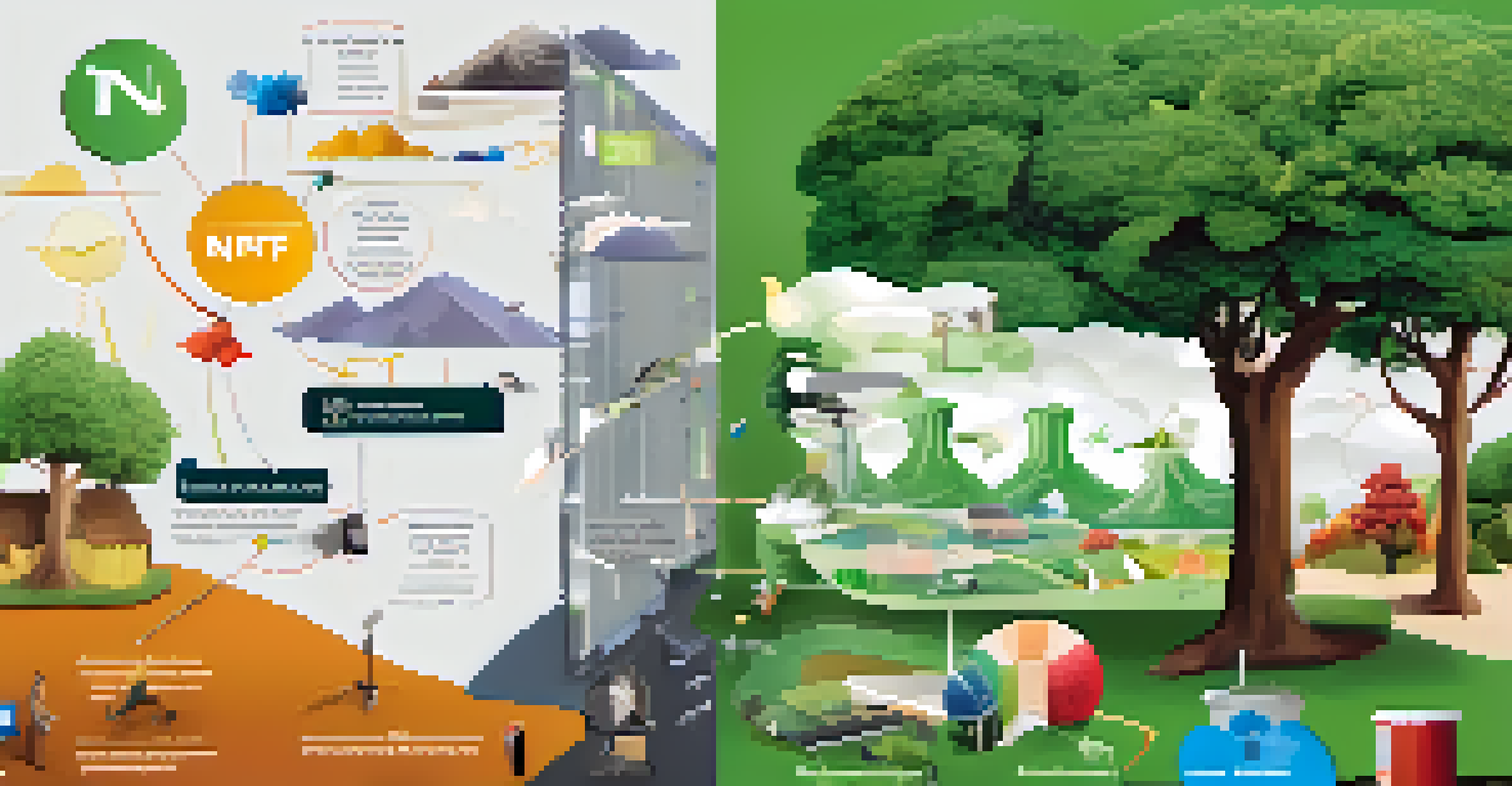The Environmental Impact of NFT Technology and Solutions

What Are NFTs and How Do They Work?
Non-fungible tokens, or NFTs, are unique digital assets that represent ownership of a specific item or piece of content on a blockchain. Unlike cryptocurrencies such as Bitcoin, NFTs are not interchangeable, making each one distinct. They can encompass anything from digital art to music and even virtual real estate.
We cannot solve our problems with the same thinking we used when we created them.
The technology behind NFTs relies on blockchain, which records transactions in a decentralized way. This means that once an NFT is created, its ownership and transaction history are securely stored. However, this process requires significant computational power, leading to concerns about its environmental footprint.
To grasp the environmental impact of NFTs, it's essential to understand the energy consumption associated with blockchain networks, especially those using proof-of-work mechanisms, which require extensive computational resources. This sets the stage for a deeper discussion on sustainability in the NFT space.
The Carbon Footprint of NFT Transactions
NFT transactions, especially on popular platforms, produce a notable carbon footprint due to the energy-intensive processes involved in minting and trading these tokens. Each transaction can release as much CO2 as driving a car for several miles. This alarming statistic has raised eyebrows among environmentalists and NFT creators alike.

For instance, Ethereum, the predominant blockchain for NFTs, has been criticized for its high energy consumption. The network's proof-of-work model has raised concerns about how the growing popularity of NFTs could escalate energy usage and further contribute to climate change.
NFTs Have Unique Environmental Costs
NFTs, while innovative, come with significant environmental impacts due to the energy-intensive blockchain processes involved in their creation and trading.
As awareness of these impacts grows, many artists and buyers are now reconsidering their role in the NFT ecosystem and exploring ways to offset their carbon emissions.
Comparing Energy Use: NFTs vs. Traditional Art
When assessing the environmental impact of NFTs, it's helpful to compare them with traditional art forms. Creating and selling physical art involves materials, transportation, and gallery exhibitions, which all have their own environmental costs. However, NFTs introduce a new layer of digital consumption, often intensifying the debate around sustainability.
The greatest threat to our planet is the belief that someone else will save it.
For example, while a traditional painting may require resources like paint, canvas, and shipping, NFTs rely heavily on digital infrastructure that consumes large amounts of energy. This can lead to a paradox where digital art, often seen as less resource-intensive, has a hidden environmental cost.
Ultimately, this comparison emphasizes the need for a more nuanced understanding of sustainability across different art forms, pushing creators to seek solutions that minimize environmental harm.
Emerging Solutions for Sustainable NFTs
In response to the environmental concerns surrounding NFTs, several innovative solutions are emerging. One significant approach is the shift towards blockchains that utilize proof-of-stake mechanisms, which consume significantly less energy compared to their proof-of-work counterparts. This change can drastically reduce the carbon footprint of NFT transactions.
Additionally, some NFT platforms are now incorporating carbon offsets into their business models, allowing creators and buyers to contribute to environmental initiatives with every transaction. This way, the NFT community can play a part in combating climate change while still enjoying the benefits of digital ownership.
Artists Can Drive Eco-Friendly Change
Artists in the NFT space have the potential to promote sustainability by choosing eco-conscious platforms and supporting environmental causes.
These solutions highlight the potential for the NFT space to evolve and adapt, paving the way for a more sustainable future without sacrificing creativity or innovation.
The Role of Artists in Promoting Sustainability
Artists have a powerful voice in the NFT space, and many are using it to promote sustainability. By choosing eco-friendly platforms and advocating for responsible practices, they can influence both their audiences and fellow creators. This sense of responsibility can help shift the narrative around NFTs toward a more positive and environmentally-conscious direction.
For instance, some artists are creating NFTs that directly support environmental causes, donating a portion of their sales to organizations focused on conservation and climate action. This not only raises awareness but also aligns their work with their values, fostering a community of like-minded individuals.
By taking a stand, artists can inspire others to think critically about their digital footprint and encourage a collective effort toward sustainability in the art world.
The Future of NFTs and Environmental Responsibility
As the NFT market continues to grow, the conversation around environmental responsibility is more crucial than ever. The industry's future hinges on its ability to address these concerns while maintaining its innovative spirit. Stakeholders, from artists to buyers, need to engage in discussions about sustainability to shape a more responsible NFT landscape.
Moreover, as technology advances, there will likely be new methods and practices that can further minimize the environmental impact of NFTs. Keeping an eye on these developments can provide valuable insights into how the industry can evolve while being mindful of its ecological footprint.
Future Solutions for Sustainable NFTs
The NFT industry is exploring innovative solutions, such as proof-of-stake blockchains and carbon offsets, to reduce its carbon footprint.
Ultimately, the goal is to find a balance where creativity flourishes without compromising the health of our planet.
Conclusion: Navigating NFTs Responsibly
In conclusion, while NFTs offer exciting opportunities for digital ownership and creativity, they come with significant environmental implications. Understanding these impacts is the first step toward fostering a responsible approach within the NFT community. By exploring sustainable solutions and supporting eco-conscious practices, we can work together to mitigate these effects.
The future of NFTs does not have to be at odds with environmental stewardship. With increasing awareness and proactive measures, it’s possible to embrace this digital frontier while protecting our planet. As consumers, artists, and innovators, we all play a part in shaping this narrative.

So, as you dive into the world of NFTs, consider the ecological footprint of your choices and join the movement toward a more sustainable future.